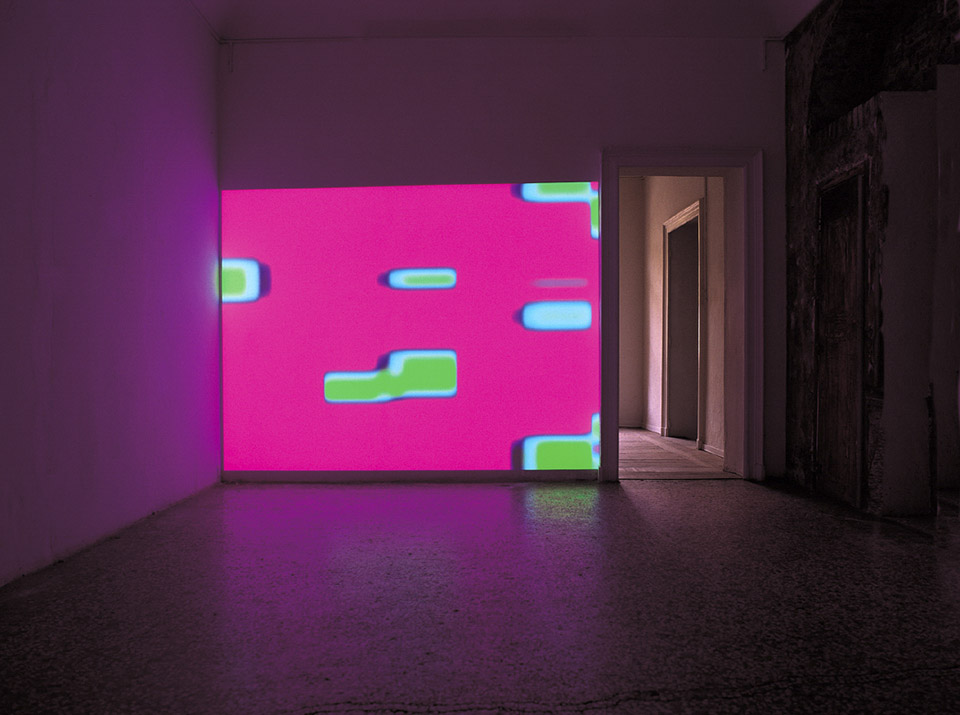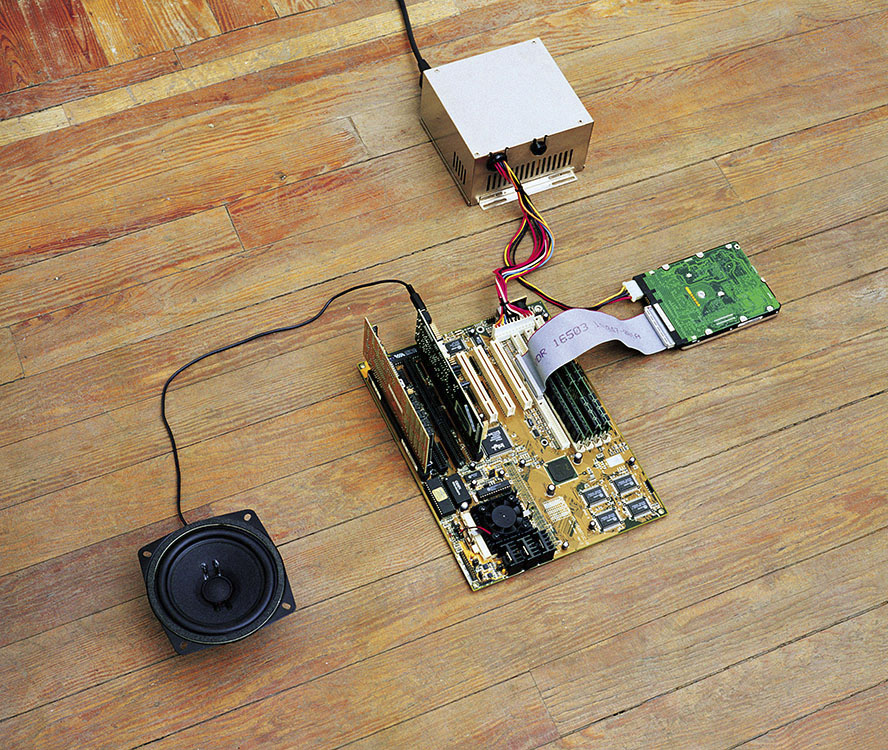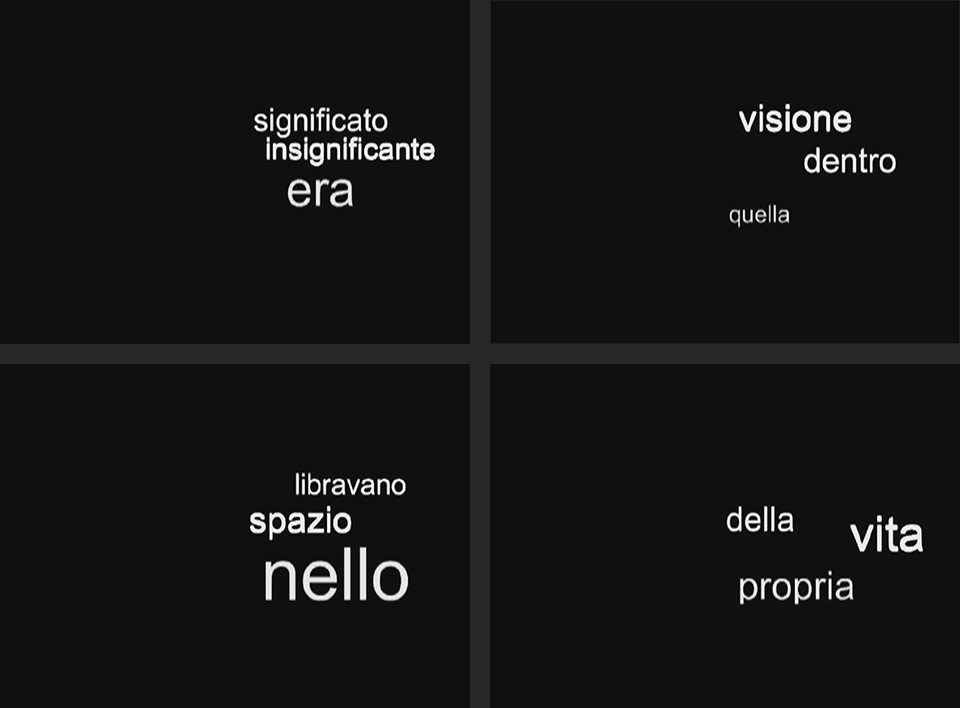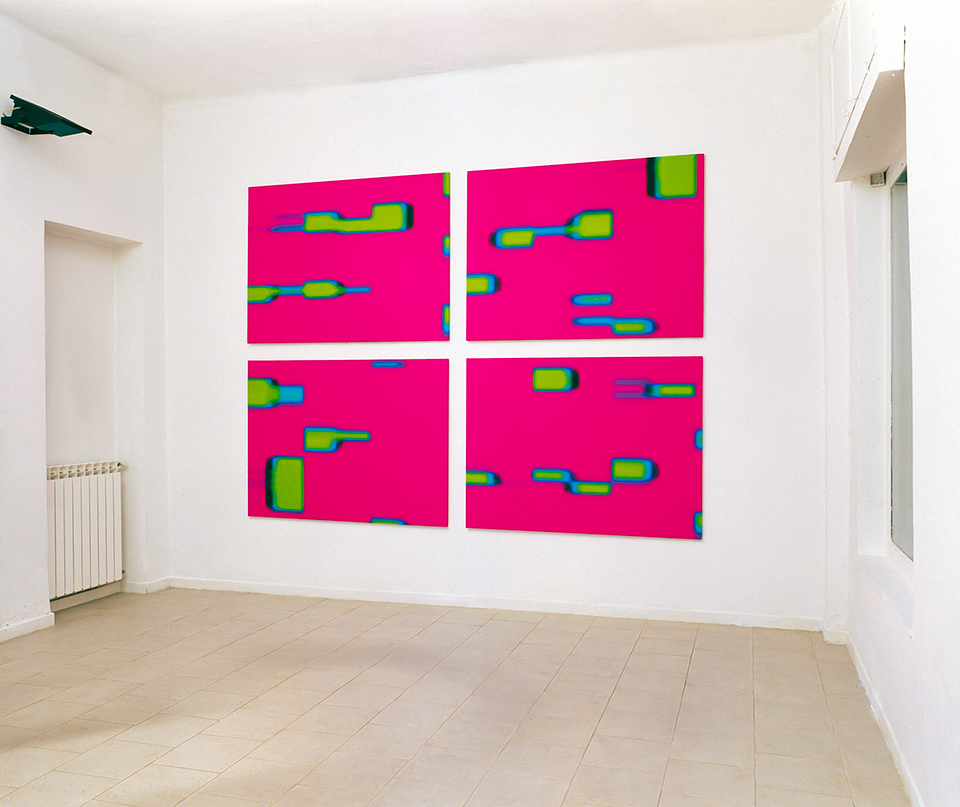Bianco-Valente: Slow Brain, 2001-2002, Galleria Antonella Nicola, Torino

Bianco-Valente, Slow Brain, Videoprojection, 2001

Bianco-Valente, Machine is Dreaming, installation view, 2001

Slow Brain, Video w/o Sound, endless loop, 2001

Slow Brain, 4 plotter on canvas, Installation view, 2001
Slow Brain, la nostra prima personale a Torino nella Galleria Antonella Nicola, è incentrata sulle capacità che hanno alcune sostanze chimiche, assunte anche in quantità minime, di alterare il delicato equilibrio biochimicho della nostra corteccia cerebrale, distorcendo così la percezione che abbiamo della realtà esterna e il modo in cui interagiamo con essa.
I lavori, legati tra loro da un continuo gioco di rimandi fra la relazione naturale-artificiale e la dualità corpo-mente, sono tutti frutto delle nostre più recenti sperimentazioni.
"Slow Brain", la videoproiezione da cui abbiamo tratto anche alcune immagini stampate su tela, che compongono un'installazione a parete, è l'elaborazione e la rappresentazione video dei risultati di un esperimento scientifico, che tende a stabilire, in persone che hanno assunto sostanze chimiche psicoattive, il tipo, la durata e l'intensità delle reazioni a degli stimoli esterni che queste sostanze determinano nelle diverse aree della corteccia cerebrale.
Il video "Altered State" è composto da alcune frasi tratte dai diari che il chimico svizzero Albert Hofmann ha tenuto nel 1943, quando, subito dopo aver scoperto fortuitamente l'LSD e le potenzialità che essa aveva di alterare le nostre strutture sensoriali, decise di sperimentare su se stesso gli effetti sconvolgenti che questa sostanza aveva sulla psiche, stilando un preciso resoconto della quantità di LSD assunta, della durata del suo effetto e delle distorsioni percettive che essa innescava.
Le pagine dei diari venivano redatte alla fine di ogni esperimento e Hofmann si sentiva frustrato di poter descrivere solo con le parole il mondo artificiale in cui era stato proiettato dalle alterazioni chimiche indotte dall'LSD sulla sua mente.
Abbiamo scelto di realizzare un lavoro su Hofmann e i suoi diari per la loro forte connotazione simbolica, si tratta infatti del primo essere umano venuto in contatto con una sostanza allucinogena di sintesi, ed è curioso notare come un uomo di scienza abbia usato delle frasi così poetiche per descrivere le sue esperienze in un mondo in cui niente era più certo e definibile.
Per l'installazione "Machine is dreaming", abbiamo messo a nudo un computer nella sua essenzialità, assemblando le schede elettroniche che lo compongono direttamente sul pavimento.
Alla macchina abbiamo dato un primo compito di generare un fruscio piatto (definito brown noise) per porla poi in uno stato di sospensione, sia fisica, perchè la scheda madre poggia su alcune compresse di sostanze psicoattive, sia "mentale", facendole eseguire un calcolo molto complesso, che non avrà mai fine, i cui risultati temporanei vengono usati per modulare il fruscio generato in precedenza.
Questo suono affascinante e apparentemente naturale, riprodotto da un altoparlante, viene percepito da chi ascolta come il rumore del mare, ma è in realtà un suono artificiale, il prodotto di un muto calcolo numerico che la macchina potrebbe continuare a generare all'infinito.
Slow brain, our first solo show in Turin at the Antonella Nicola Gallery, is based on the capabilities that some chemical substancies have, even if assumed in small amounts, in altering the subtle biochemical dynamics of our cortex, as a consequence our perception of external reality and the way we interact with it is distorted.
The artworks are linked each others by a subtle line, and can be considered the outcome of our latest research on the existing relations between natural and artificial and body-mind duality.
"Slow Brain" is the video processing of data sheets resulting from an experiment that some researchers performed with persons who assumed different psychoactive chemical substancies.
The test tended to determine type, duration and intensity of the reactions to external stimulations as a result of the effects these substancies caused in several areas of the cerebral cortex.
We also created an installation by taking out some images from the video and printing them on canvas.
The video titled "Altered State" is built up by using some sentencies taken from the diaries that the Swiss chemist Albert Hofmann wrote in 1943 when, in the Sandoz laboratory, during habitual researches, accidentally discovered LSD and its potentiality in altering human sensorial structures. He decided to test on himself the effects that this synthetic substance had on psyche, making a detailed report about the amount of substance assumed, the duration of its effect, and the perceptive distortions it caused.
Hofmann was used to write his diaries at the end of each experiment. He felt a strong sense of frustration because he only could describe through words the artificial world in which he was thrown as a consequence of the chemical alterations LSD caused in his mind.
The reason why we decided to work on Hofmann’s diaries is because of their strong symbolic connotation, in fact it was the first time a human being came into contact with a synthetis hallucinogen substance, and it’s interesting to note that a science oriented personality, as Hofmann was, used such poetic expressions to describe his experiences.
For the installation titled "Machine is dreaming", we assembled directly on the floor the electronic components that constitute a functioning computer.
We gave to the naked machine the task to generate a flat noise (called brown noise). After that, we set it in a suspension state, both physical, because the mainboard is placed on 4 pills of psychoactive substancies, and “mental”, because the machine is involved into an endless calculation, whose intermediate results are used by itself to modulate the noise previously generated.
This fascinating and apparently natural sound, reproduced by a loudspeaker, is perceived by people as the seashore sound, but it is a pure artificial sound, the result of a mute numeric calculation, that the machine could virtually continue generating to infinity.
Recensioni / Reviews
- Bianco-Valente, Slow Brain, di T. Conti, Tema Celeste, gennaio
- Bianco-Valente, Slow Brain, di D. Salani, Arte e Critica, gen/mar
- Bianco-Valente, Slow Brain, di M. C. Strati, Exibart 30 novembre 2001 (Link) (Pdf)
home | works | texts/testi | video | contacts/contatti